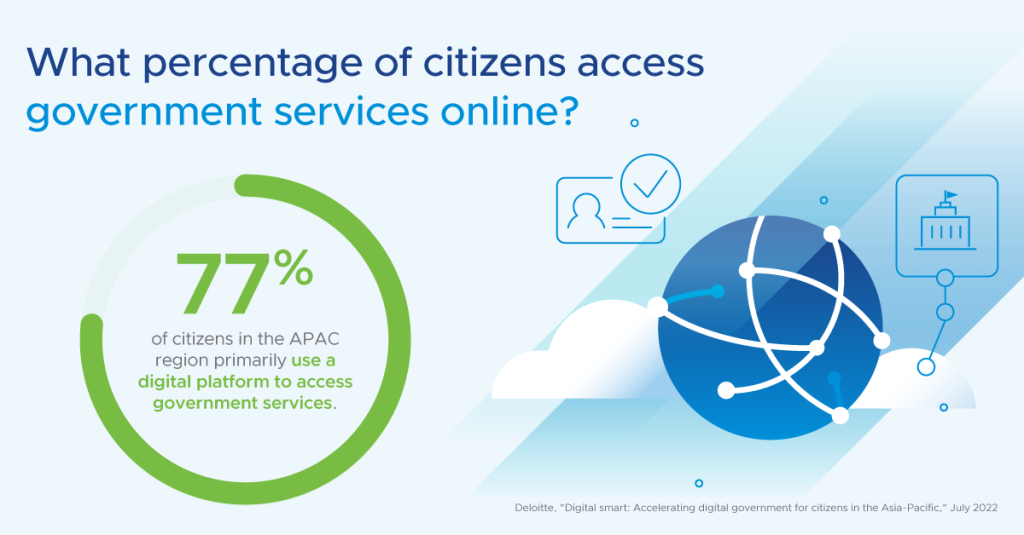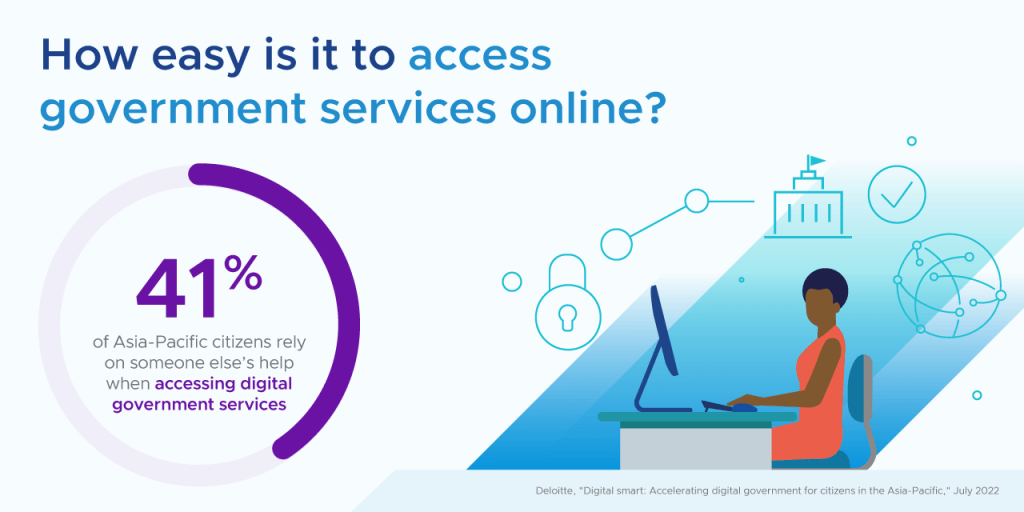Digital platforms are fast becoming the predominant way many citizens access government services in our region. Today in many countries it’s possible to securely store your proof of COVID-19 vaccination online, apply for government support or access your health records with the click of a button.
The rapid growth in digitisation has been driven by citizens’ changing expectations.

As well as improving overall delivery of services, governments can also use digital service to advance equity and inclusion for groups of citizens that have traditionally found it more difficult to access essential services.
For example, digital services can promote equitable access for people living in regional and rural areas, cutting out the need for long journeys to attend face-to-face appointments. Similarly, by reducing the need for in-person contact, digital services can make it easier for those with limited mobility to access support.
But as much as digital services can be more inclusive, they also have the potential to exclude some groups if not designed thoughtfully.
Some citizens, such as the elderly or those with a disability, could face additional barriers when accessing digital platforms. Without an easy-to-navigate process, they could miss out on critical services like healthcare at a time in their lives when they need it most.
A key objective of digitisation is to improve accessibility and inclusion, but it’s imperative that governments account for all citizens.
Barriers to access
Deloitte’s research, Digital smart: Accelerating digital government for citizens in the Asia-Pacific, launched in partnership with VMware last year, shines a light on how governments around the region are increasing digital service delivery.

Overall, the research paints a positive picture of improving access to services in our region. But one finding really stood out for me: a substantial proportion (41%) of citizens in Asia-Pacific rely on someone else’s help to access digital government services.
Being unable to use an online platform without assistance may prevent people who are isolated, or who live alone, from accessing services in a timely way – or at all.
Even among the digitally literate, there can still be practical considerations that make it difficult to access services digitally.
This is something I have experienced myself.
When we emerged from the thick of the pandemic and business travel resumed, I needed to prove a digital certificate as proof of my COVID-19 vaccination status through a mobile app in order to enter and leave Australia.
When I did not arrange this in advance, I had to quickly organise it at the airport. In theory, digital service delivery should make this relatively straightforward. My digital skills weren’t a barrier, but it proved to be surprisingly challenging to find a plain white wall in the airport to take my photo for the mobile app as part of the process.
While frustrating, it was a minor inconvenience rather than a significant problem. But it prompted me to think about the far greater number of challenges that people from many diverse groups face daily when trying to access government services.
Cumbersome processes can prevent people from accessing the government services they need. This not only disadvantages them, but our society as a whole: we are all worse off when diverse groups are held back from fully participating in everyday life.
Driving accessibility through digital platforms
Democratising access to digital services requires governments to keep accessibility front of mind.
There are myriad ways by which inclusion can be improved. For example, is it possible to set up systems to autofill personal data previously entered on a government website, making interaction easier for people for whom typing and other data entry methods may be more difficult? Can AI-powered chatbots be used to assist people with vision impairment? Or could a one-stop shop for all government services be established so that citizens only have to learn how to access one platform?
One excellent example of digital accessibility and inclusion in action is Indonesia’s Laku Pandai program, which provides citizens with reliable and safe access to banking and other financial services. Developed to improve financial equality in Indonesia, Laku Pandai aims to provide easy-to-understand financial products, such as credit and financing options for micro-customers, microinsurance and basic savings accounts, to reach citizens who may have traditionally been excluded from accessing financial services.
Further afield in Australia, the Service NSW app, which was borne out of a partnership between VMware and Service NSW, enables citizens to access myriad offerings, such as a digital-version of their driver's license, or request financial support in a crisis. The familiarity of the app enables anyone with a phone to easily and quickly find support.
In 2021, Service NSW introduced training to equip all Digital Services team members with the skills to identify and develop solutions to resolve accessibility problems in the app. The agency also ensures developers adhere to inclusive design practices so that people with disabilities or those from culturally and linguistically diverse backgrounds have equal access.
Service NSW continues to add to the application. This year, Service NSW plans to launch Australia’s first Digital Birth Certificate (DBC), providing citizens with the ability to access their birth certificate without the worry of misplacing this critical form of identification. The app has been built according to international accessibility standards (WCAG 3.0) with assistive technology such as VoiceOver, Zoom and 40-cell Refreshable Braille Display.
People who are blind or have low vision will not have a driver’s licence which is commonly used for identification. They may need to use paper documentation, such as a birth certificate which can be easily lost or damaged, as a form of identification.
Service NSW is piloting the DBC with 100 clients of Vision Australia, a leading provider of services for people who are blind or have low vision. Their first-hand experience using the app will help to ensure it is as accessible and inclusive as possible before being officially launched.
By making the tools more accessible, you’re also undoubtedly improving the user experience for all.
Technology with heart
Involving people from diverse backgrounds, such as the elderly and people living with disability, in the co-design of government services and technology platforms is one of the best ways to ensure your product doesn’t marginalise the very groups you’re trying to reach.
With the launch of each new product or service, governments should also ensure citizens have the necessary skills and resources to easily access support. Short digital literacy courses could be made available through local libraries and community centres or accessed online. These can go a long way in improving accessibility for people who may need extra support.
Without careful planning, the transition to digital government services runs the risk of leaving some groups behind. Adopting a user-centric approach and designing products through a social lens are key to minimising this risk. It’s the only way that government services can achieve their intended purpose: to provide essential support to all citizens from all walks of life.

